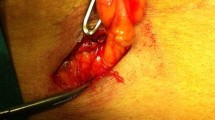Abstract
Purpose
When encountered, a femoral hernia requires repair due to its propensity for incarceration with associated morbidity and mortality. Several operations have been described, including the low approach (Lockwood), the high approach (Lotheisen) and McEvedy’s preperitoneal approach. Recently, laparoscopic repair has also been advocated. The Nyhus–Condon repair, a transverse abdominal preperitoneal repair, was first employed in 1943 and has been widely used since. The aim of this study was to describe our modification of the Nyhus–Condon repair.
Methods
A retrospective review of all patients who underwent this repair over an 18-year period was performed.
Results
Twenty-seven patients were included in the study. The female:male ratio was 16:11. Sixteen operations were performed as emergencies. Four patients required resection of a segment of bowel, which was performed through the same incision. There were no immediate post-operative complications. No recurrence was noted with a median follow-up of 4 years.
Conclusion
The Nyhus–Condon repair offers an alternative approach to femoral hernia repair and has the advantages of allowing bowel resection through the same incision with a better cosmetic outcome than the alternative preperitoneal McEvedy repair.


Similar content being viewed by others
References
Büchin P, Steinau G, Ophoff K, Dreuw B, Truong SN, Schumpelick V (1999) Femoral hernia in childhood: evaluation of sonography as a diagnostic aid. Hernia 3:19–21
Sandblom G, Haapaniemi S, Nilsson E (1999) Femoral hernias: a register analysis of 588 repairs. Hernia 3:131–134
Bekoe S (1973) Prospective analysis of the management of incarcerated and strangulated inguinal hernias. Am J Surg 126(5):665–668
Brasso K, Løndal Nielsen K, Christiansen J (1989) Long-term results of surgery for incarcerated groin hernia. Acta Chir Scand 155(11–12):583–585
Glassow F (1985) Femoral hernia. Review of 2,105 repairs in a 17 year period. Am J Surg 150(3):353–356
Naude GP, Ocon S, Bongard F (1997) Femoral hernia: the dire consequences of a missed diagnosis. Am J Emerg Med 15(7):680–682
Maingot R (1968) The choice of operation for femoral hernia, with special reference to McVay’s technique. Br J Clin Pract 22(8):323–329
Waddington RT (1971) Femoral hernia: a recent appraisal. Br J Surg 58(12):920–922
Felix EL, Michas CA, Gonzalez MH Jr (1997) Laparoscopic hernioplasty: why does it work? Surg Endosc 11(1):36–41
Ponka JL, Brush BE (1971) Problem of femoral hernia. Arch Surg 102(4):417–423
Rhind JR (1971) Lateral femoral hernia. J R Coll Surg Edinb 16(5):299–300
Hachisuka T (2003) Femoral hernia repair. Surg Clin North Am 83(5):1189–1205
Ferzli G, Shapiro K, Chaudry G, Patel S (2004) Laparoscopic extraperitoneal approach to acutely incarcerated inguinal hernia. Surg Endosc 18(2):228–231
Legnani GL, Rasini M, Pastori S, Sarli D (2008) Laparoscopic trans-peritoneal hernioplasty (TAPP) for the acute management of strangulated inguino-crural hernias: a report of nine cases. Hernia 12(2):185–188
Keynes WM (1964) WJ Hudson’s operation for femoral hernia, 1st edn. JB Lippincott, Philadelphia
Anson BJ, McVay CB (1984) Surgical anatomy, 6th edn. Saunders, Philadelphia
McEntee GP, O’Carroll A, Mooney B, Egan TJ, Delaney PV (1989) Timing of strangulation in adult hernias. Br J Surg 76(7):725–726
Kulah B, Kulacoglu IH, Oruc MT, Duzgun AP, Moran M, Ozmen MM, Coskun F (2001) Presentation and outcome of incarcerated external hernias in adults. Am J Surg 181(2):101–104
Oishi SN, Page CP, Schwesinger WH (1991) Complicated presentations of groin hernias. Am J Surg 162(6):568–570; discussion 571
Franklin ME Jr, Trevino JM, Portillo G, Vela I, Glass JL, González JJ (2008) The use of porcine small intestinal submucosa as a prosthetic material for laparoscopic hernia repair in infected and potentially contaminated fields: long-term follow-up. Surg Endosc 22(9):1941–1946
Chan G, Chan CK (2005) A review of incisional hernia repairs: preoperative weight loss and selective use of the mesh repair. Hernia 9(1):37–41
Chan G, Chan CK (2008) Longterm results of a prospective study of 225 femoral hernia repairs: indications for tissue and mesh repair. J Am Coll Surg 207(3):360–367
Bisgaard T, Bay-Nielsen M, Kehlet H (2008) Re-recurrence after operation for recurrent inguinal hernia. A nationwide 8-year follow-up study on the role of type of repair. Ann Surg 247(4):707–711
Author information
Authors and Affiliations
Corresponding author
Rights and permissions
About this article
Cite this article
Babar, M., Myers, E., Matingal, J. et al. The modified Nyhus–Condon femoral hernia repair. Hernia 14, 271–275 (2010). https://doi.org/10.1007/s10029-009-0606-y
Received:
Accepted:
Published:
Issue Date:
DOI: https://doi.org/10.1007/s10029-009-0606-y




